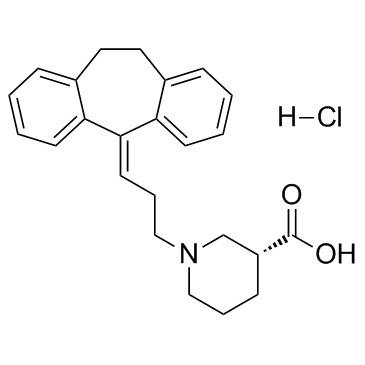ReN-1869 hydrochloride (NNC-05-1869 hydrochloride) (Synonyms: NNC-05-1869 hydrochloride) |
| Catalog No.GC31812 |
ReN 1869 hydrochloride is a novel, selective histamine H1 receptor antagonist, which demonstrates affinity to the histamine H1 receptor (guinea pig brain) with Ki of 0.19±0.04 μM and the non-selective σ site (guinea pig brain) with Ki of 0.45 μM.
Products are for research use only. Not for human use. We do not sell to patients.

Cas No.: 170149-76-5
Sample solution is provided at 25 µL, 10mM.
ReN 1869 hydrochloride is a novel, selective histamine H1 receptor antagonist, which demonstrates affinity to the histamine H1 receptor (guinea pig brain) with Ki of 0.19±0.04 μM and the non-selective σ site (guinea pig brain) with Ki of 0.45 μM.
ReN 1869 is a highly selective tricyclic antihistamine that shows functional histamine H1 receptor antagonism. Binding studies with radioactively labelled ReN 1869 reveals high affinity only for the histamine H1 receptor in addition to some affinity for a sigma site. ReN 1869 is profiled for activity at 10 μM at various receptors, transporters, enzymes and ion channels. ReN 1869 only demonstrates affinity to the histamine H1 receptor (guinea pig brain, [3H]pyrilamine) with a Ki of 0.19±0.04 μM and the non-selective σ site [guinea pig brain, [3H]1,3-di-tolylguanidine (DTG)] with a Ki of 0.45 μM. ReN 1869 dose-dependently reduces the responses with IC50 of 1.70±0.002 μM[1].
The in vivo binding of [3H]Mepyramine to mouse spinal cord and cerebellar histamine H1 receptors is dose-dependently inhibited by ReN 1869. ReN 1869 (in doses as low as 10 μg/kg i.p.) significantly inhibits the histamine-evoked paw edema. The ED50 is approximately 300 μg/kg. Interestingly, even a high dose of Mepyramine (10 mg/kg) is unable to inhibit significantly this type of edema (0.29±0.06 versus 0.34±0.05 in controls, n=7).ReN 1869 (1 mg/kg s.c.) is administered 30 min before paw injection with carrageenan and has no effect on the development of the paw edema. Dexamethasone (1 mg/kg s.c.) is given 1 h before carrageenan and expectedly diminished the edema. This effect is not affected by the simultaneous administration of 1 mg/kg ReN 1869[1].
[1]. Olsen UB, et al. ReN 1869, a novel tricyclic antihistamine, is active against neurogenic pain and inflammation. Eur J Pharmacol. 2002 Jan 18;435(1):43-57.
Average Rating: 5 (Based on Reviews and 1 reference(s) in Google Scholar.)
GLPBIO products are for RESEARCH USE ONLY. Please make sure your review or question is research based.
Required fields are marked with *




















